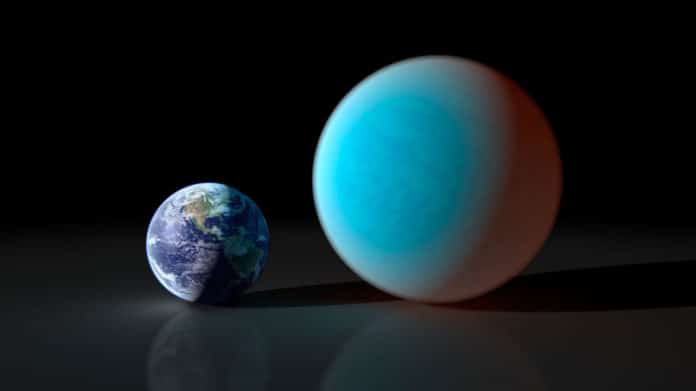The exoplanet community already has ways to detect an H2 atmosphere by transmission spectroscopy. However, the mass of the H2 atmosphere – the parameter that controls the temperature at the bottom of the atmosphere and thus the possibility for liquid water is not directly measurable from the transmission spectrum.
In a new study, scientists created a new technique that could help them narrow their search for potentially habitable exoplanets or planets beyond our solar system. They have shown that using the chemistry of the planet’s atmosphere – chemicals in an exoplanet’s atmosphere- could reveal clues about what lies beneath – specifically, which planets are too hot to support liquid-water oceans.
The study suggests that chemicals might point to hidden oceans on exoplanets between 1.7 and 3.5 times the diameter of Earth. Due to their larger size than Earth, these exoplanets are sometimes known as ‘sub-Neptunes.’
Neptunian exoplanets often have a thick atmosphere that traps heat on the surface and raises the temperature. If the atmosphere reaches a certain threshold – typically about 1,430 degrees Fahrenheit (770 degrees Celsius) – it will undergo a thermochemical equilibrium that changes its chemical profile.
Once the process begins, carbon and nitrogen will predominantly be in the form of methane and ammonia. These chemicals are not present in cooler, thinner atmospheres. In such a case, the dominant forms of carbon and nitrogen would be carbon dioxide and molecules of two nitrogen atoms.
Also, there are additional signs that indicate a liquid-water ocean underneath the atmosphere. Those signs include the absence of nearly all stray ammonia, which would be dissolved in the ocean. According to scientists, if there exists an ocean underneath, the atmosphere should be virtually free of ammonia.
In addition, there would be more carbon dioxide than carbon monoxide in the atmosphere; by contrast, after thermochemical equilibrium, there should be more carbon monoxide than carbon dioxide if there are detectable amounts of either.
Renyu Hu, a researcher at NASA’s Jet Propulsion Laboratory, who led the study, said, “If we see the signatures of thermochemical equilibrium, we would conclude that the planet is too hot to be habitable. Vice versa, if we do not see the signature of thermochemical equilibrium and also see signatures of gas dissolved in a liquid-water ocean, we would take those as a strong indication of habitability.”
“We don’t have direct observational evidence to tell us what the common physical characteristics for sub-Neptunes are. Many may have massive hydrogen atmospheres, but quite a few could still be ‘ocean planets.’ I hope this paper will motivate many more observations soon to find out.”
NASA’s James Webb Space Telescope, set to launch Dec. 18, will carry a spectrometer capable of studying exoplanet atmospheres. The mission aims to see those atmospheres and what they could reveal about these distant worlds.
Journal Reference:
- Renyu Hu, Mario Damiano et al. Unveiling shrouded oceans on temperate sub-Neptunes via transit signatures of solubility equilibria vs. gas thermochemistry. arXiv:2108.04745
